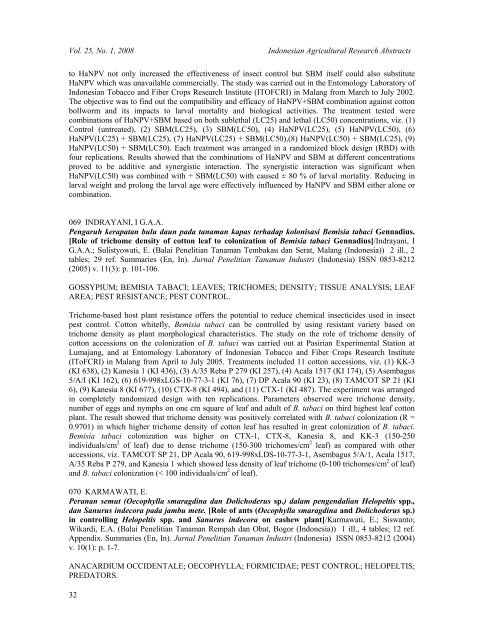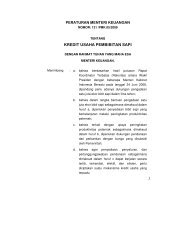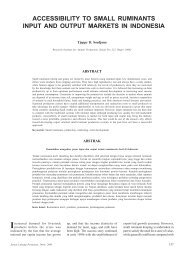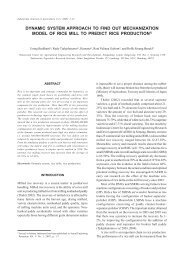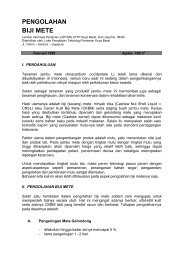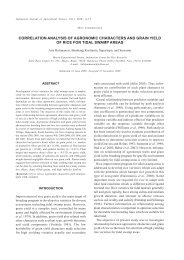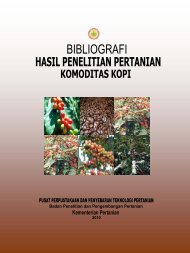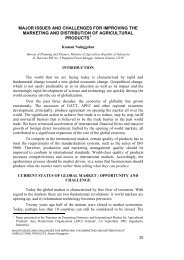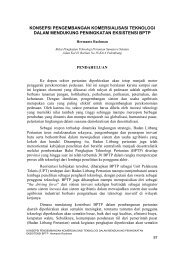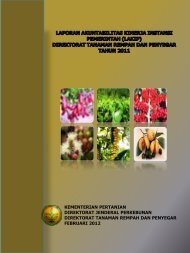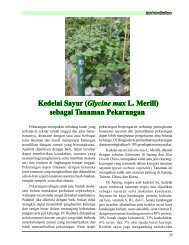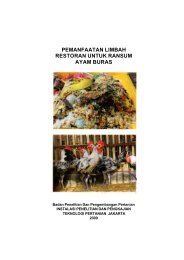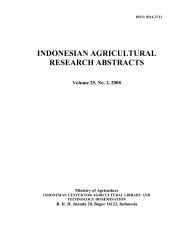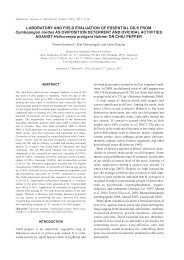IARA Vol. XXV No. 1 Year. 2008 (pdf, 1000 kb) - Pustaka Deptan
IARA Vol. XXV No. 1 Year. 2008 (pdf, 1000 kb) - Pustaka Deptan
IARA Vol. XXV No. 1 Year. 2008 (pdf, 1000 kb) - Pustaka Deptan
You also want an ePaper? Increase the reach of your titles
YUMPU automatically turns print PDFs into web optimized ePapers that Google loves.
<strong>Vol</strong>. 25, <strong>No</strong>. 1, <strong>2008</strong><br />
Indonesian Agricultural Research Abstracts<br />
to HaNPV not only increased the effectiveness of insect control but SBM itself could also substitute<br />
HaNPV which was unavailable commercially. The study was carried out in the Entomology Laboratory of<br />
Indonesian Tobacco and Fiber Crops Research Institute (ITOFCRI) in Malang from March to July 2002.<br />
The objective was to find out the compatibility and efficacy of HaNPV+SBM combination against cotton<br />
bollworm and its impacts to larval mortality and biological activities. The treatment tested were<br />
combinations of HaNPV+SBM based on both sublethal (LC25) and lethal (LC50) concentrations, viz. (1)<br />
Control (untreated), (2) SBM(LC25), (3) SBM(LC50), (4) HaNPV(LC25), (5) HaNPV(LC50), (6)<br />
HaNPV(LC25) + SBM(LC25), (7) HaNPV(LC25) + SBM(LC50),(8) HaNPV(LC50) + SBM(LC25), (9)<br />
HaNPV(LC50) + SBM(LC50). Each treatment was arranged in a randomized block design (RBD) with<br />
four replications. Results showed that the combinations of HaNPV and SBM at different concentrations<br />
proved to be additive and synergistic interaction. The synergistic interaction was significant when<br />
HaNPV(LC50) was combined with + SBM(LC50) with caused ± 80 % of larval mortality. Reducing in<br />
larval weight and prolong the larval age were effectively influenced by HaNPV and SBM either alone or<br />
combination.<br />
069 INDRAYANI, I G.A.A.<br />
Pengaruh kerapatan bulu daun pada tanaman kapas terhadap kolonisasi Bemisia tabaci Gennadius.<br />
[Role of trichome density of cotton leaf to colonization of Bemisia tabaci Gennadius]/Indrayani, I<br />
G.A.A.; Sulistyowati, E. (Balai Penelitian Tanaman Tembakau dan Serat, Malang (Indonesia)) 2 ill., 2<br />
tables; 29 ref. Summaries (En, In). Jurnal Penelitian Tanaman Industri (Indonesia) ISSN 0853-8212<br />
(2005) v. 11(3): p. 101-106.<br />
GOSSYPIUM; BEMISIA TABACI; LEAVES; TRICHOMES; DENSITY; TISSUE ANALYSIS; LEAF<br />
AREA; PEST RESISTANCE; PEST CONTROL.<br />
Trichome-based host plant resistance offers the potential to reduce chemical insecticides used in insect<br />
pest control. Cotton whitefly, Bemisia tabaci can be controlled by using resistant variety based on<br />
trichome density as plant morphological characteristics. The study on the role of trichome density of<br />
cotton accessions on the colonization of B. tabaci was carried out at Pasirian Experimental Station at<br />
Lumajang, and at Entomology Laboratory of Indonesian Tobacco and Fiber Crops Research Institute<br />
(IToFCRI) in Malang from April to July 2005. Treatments included 11 cotton accessions, viz. (1) KK-3<br />
(KI 638), (2) Kanesia 1 (KI 436), (3) A/35 Reba P 279 (KI 257), (4) Acala 1517 (KI 174), (5) Asembagus<br />
5/A/I (KI 162), (6) 619-998xLGS-10-77-3-1 (KI 76), (7) DP Acala 90 (KI 23), (8) TAMCOT SP 21 (KI<br />
6), (9) Kanesia 8 (KI 677), (10) CTX-8 (KI 494), and (11) CTX-1 (KI 487). The experiment was arranged<br />
in completely randomized design with ten replications. Parameters observed were trichome density,<br />
number of eggs and nymphs on one cm square of leaf and adult of B. tabaci on third highest leaf cotton<br />
plant. The result showed that trichome density was positively correlated with B. tabaci colonization (R =<br />
0.9701) in which higher trichome density of cotton leaf has resulted in great colonization of B. tabaci.<br />
Bemisia tabaci colonization was higher on CTX-1, CTX-8, Kanesia 8, and KK-3 (150-250<br />
individuals/cm 2 of leaf) due to dense trichome (150-300 trichomes/cm 2 leaf) as compared with other<br />
accessions, viz. TAMCOT SP 21, DP Acala 90, 619-998xLDS-10-77-3-1, Asembagus 5/A/1, Acala 1517,<br />
A/35 Reba P 279, and Kanesia 1 which showed less density of leaf trichome (0-100 trichomes/cm 2 of leaf)<br />
and B. tabaci colonization (< 100 individuals/cm 2 of leaf).<br />
070 KARMAWATI, E.<br />
Peranan semut (Oecophylla smaragdina dan Dolichoderus sp.) dalam pengendalian Helopeltis spp.,<br />
dan Sanurus indecora pada jambu mete. [Role of ants (Oecophylla smaragdina and Dolichoderus sp.)<br />
in controlling Helopeltis spp. and Sanurus indecora on cashew plant]/Karmawati, E.; Siswanto;<br />
Wikardi, E.A. (Balai Penelitian Tanaman Rempah dan Obat, Bogor (Indonesia)) 1 ill., 4 tables; 12 ref.<br />
Appendix. Summaries (En, In). Jurnal Penelitian Tanaman Industri (Indonesia) ISSN 0853-8212 (2004)<br />
v. 10(1): p. 1-7.<br />
ANACARDIUM OCCIDENTALE; OECOPHYLLA; FORMICIDAE; PEST CONTROL; HELOPELTIS;<br />
PREDATORS.<br />
32


